Vickers Viscount Network
May 2012 Newsletter
Dear Member
Welcome to the first issue of the Vickers Viscount Network newsletter of 2012. The team would like to express its apologies
that this issue has taken until May to be published. Also, we've been training up a new member of the newsletter team, Simon Ellwood
who we'd all like to welcome on-board.
First Viscount pilot to be endorsed joins Vickers Viscount Network
We get many interesting emails but the following from Brian Powell would have to be one of the most fascinating.
“Firstly – to introduce myself. My name is Brian Powell. I am 90 years old and served in the RAF as a flying instructor
throughout the War. I became a commercial pilot in 1945. My only claim to fame is that I was the first Commercial Pilot’s
Licence holder to have my licence endorsed for prop-jets – the Viscount.
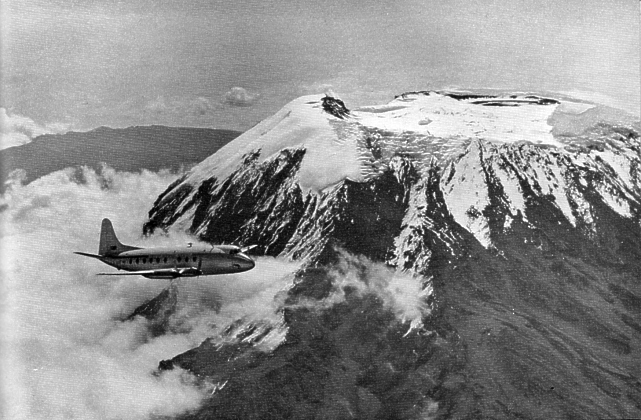
Prototype Viscount c/n 1 G-AHRF in flight near Mount Kilimanjaro
I was a test pilot with Vickers at Wisley in 1950 and went with Jock Bryce on the Viscount 630 tropical trials in
Khartoum and thereafter to Nairobi for further trials. We did a photographic exercise, flying in formation over
Kilimanjaro for publicity. Jock flew the Viscount and I flew the "chase aircraft", a Vickers Valetta, climbing
(unpressurised) to 21,000 feet with the rear door removed and the photographer - on a 'monkey lead' . . . in case
he got too enthusiastic and fell out! (Damn cold!). I still have a copy of the photograph – with the volcano in
the background. (We have included this great photo - sourced from Derek Harvey. Ed)
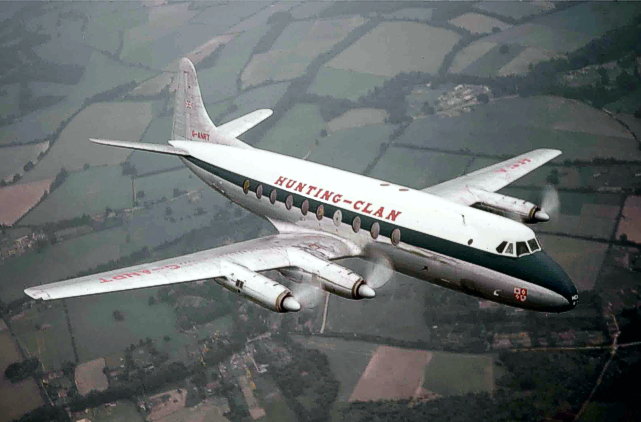
Viscount c/n 76 G-ANRT on a pre-delivery test flight, July 1955
Latterly, as Chief Training Captain of Hunting-Clan, under contract to Vickers, I did the conversion training of some 60
pilots of various customer airlines worldwide on 700, 800 and 810 Series Viscounts.
Although, I was Test Pilot for British United Group, I was involved with more modern aircraft. I also flew Viscounts on their
yearly C. of A. tests and thus kept my licence valid on the type until 1970, when I was seconded to train pilots of Arkia –
the Israeli internal airline.
The last Viscount flight recorded in my log book was on 4 May 1970 when I flew 4X-AVB from Ophia
to Lod! Incidentally, Jock Bryce, who did the first flight on the 630, is still alive (although like me, very ancient!). He
lives locally at Walton on Thames. I hope these ‘ramblings’ may be of interest to Viscount ‘aficionados’."
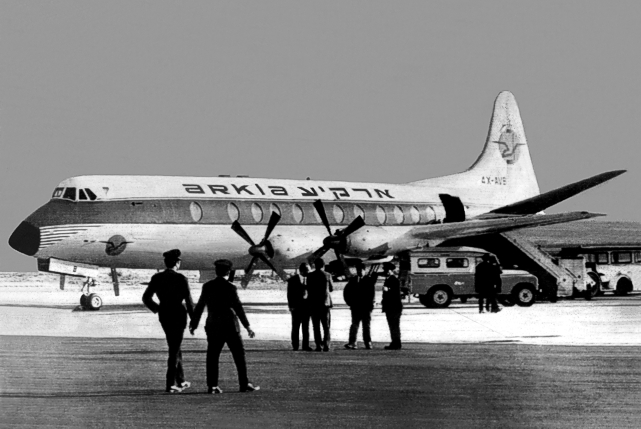
Brian's last Viscount logged, c/n 424 4X-AVB here pictured at Nicosia, Cyprus
Editor Peter Layne comments "Brian, rest assured that we Viscount 'aficionados' truly appreciate these details of your
distinguished career and welcome you to our core membership. It is a real asset that you are able to recall and relate to us
such interesting information. Thank you too for mentioning Jock Bryce. No doubt there are many things that both you and Jock
can remember of your Viscount days and we would be delighted to hear about them.
5,000 Viscount photos !
Another milestone has now been reached with the 5,000th photograph now uploaded to the website. You can always glance at the
top of any page on our website for a running total. A great achievement Geoff and Brian who in turn wish to thank so many of
you for your valued contribution.
An assessment was made a while back that there may be as many as 10,000 photos "still out there" which could be loaded. Let's
prove this to be an understatement. If you place the cursor on "Photo", just below the running total, you will see various
options as to how these photographs can be viewed.
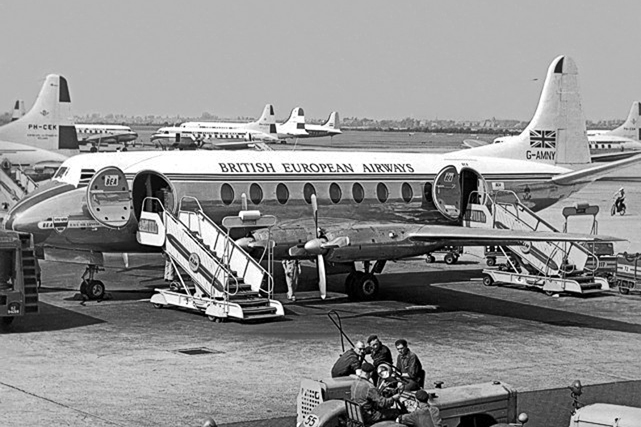
Our 5,000th Viscount photo - G-AMNY at Schiphol, Amsterdam
Technical question - Engine fuel trimmers
Alex Ford has asked, “Does anybody know if the fuel trimmers on the Viscount were:
A: All linked together with a central control i.e. push that control and all 4 move/adjust?
B: They were all individually controlled i.e. move trimmer 4 and only number 4 moved 1, 2 and 3 stayed still?
C: Was there the option of both modes i.e. you could move them all together via one control or move them individually as you wished?
Vickers Viscount Network core members Simon Ellwood and Brian Burrage responded:
Simon: “In a V745 flight manual I read that all 4 engines have separate controls that operate each engine individually (each engine will have slightly
different fuel trim/tuning characteristics). Not sure whether all could be manipulated together, but I suspect the answer is no - they were all trimmed individually.
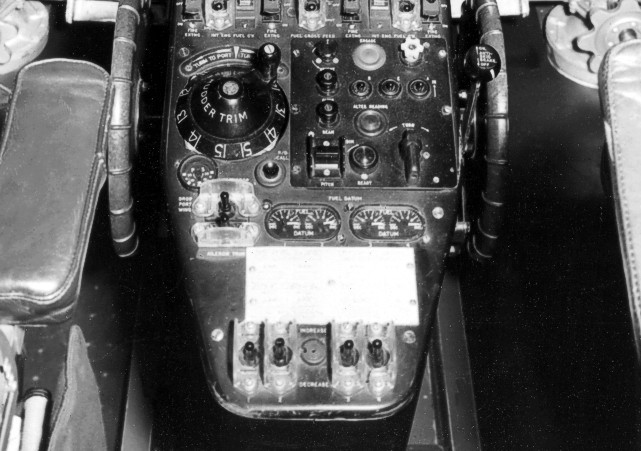
Fuel Trimmer Switches (foreground) and dials (above, with the word 'datum' on)
Brian: “As a Dart engineer I have often used the trimmer system when carrying out an installation, in-service or pre-removal ground run. Each engine
has a separate fuel trimmer switch and they are definitely not interconnected. The percentage of fuel trim set depended on the pressure altitude and outside
air temperature (OAT) at the time you wanted to start up the engines. Rolls-Royce provided charts and also supplied a little plastic dial which they described as a
'computer'. These can often be seen in cockpit photos. G-ALWF had one when it was in service on the right hand side of the cockpit for the co-pilot to use but
it isn't there now at Duxford.
Each engine variant had a different chart and 'computer'. I happen to have a 'computer' to hand and here are some examples: -
Sea level at +20°C OAT = 86% trim (100% = full fuel with the throttle set at the ground idle position)
1000 ft at +20°C OAT = 80% trim
5000 ft at +20°OAT = 58% trim
Sea level at +35°C OAT = 50% trim
1000 ft at +35°C OAT = 45% trim
5000 ft at +35°OAT = 25% trim
As you can see, the more extreme the conditions the less fuel required to start up the engine. Going the other way, the lower
the outside air temperature the more fuel is required, which would take it up to 100%. Setting up the Fuel Control Unit (FCU)
throttle arm position at ground idle was carried out during a test bed run and each engine had a different position adjusted
by shim blocks.
Starting a Dart engine is the most critical phase as it is all too easy to over temp the HP turbine blades, which was an
expensive business. A lot of pilots used to 'milk' the fuel trimmer as they started the engine in order to catch the sudden
rise in Jet Pipe Temperature (JPT) on the RDa3 and RDa6 engine or Turbine Gas Temperature (TGT) on the RDa7 and RDa10 engine
families. The trimmer switch in the cockpit was electrical and energised a servo motor connected to a mechanical linkage
system at the engine end. I hope this clarifies the situation.”
Cuba please . . .
Robert Arnold, who is writing an eagerly awaited book on Canadian Viscounts, has drawn attention to a hijacking on 11
September 1968 when Cuba was a favourite destination.
"As we all know, the Viscount was the foundation of the TCA/Air Canada intercity operations during the 1950s and 1960s. The
company couldn't have found a better plane. Although the Viscount led a mostly quiet life with the airline, there were moments
of excitement.
One in particular involved CF-TIB. On that day, 11 September 1968, Captain Ron Hollet and F/O Bob Bromley were about to depart
from St. John New Brunswick to Malton Airport, Toronto. They were approached and ordered to fly to Havana Cuba. The crew was
fortunate enough to convince the hijackers that they had to take on fuel in Dorval, Quebec. It was here they were able to end
the situation peacefully."
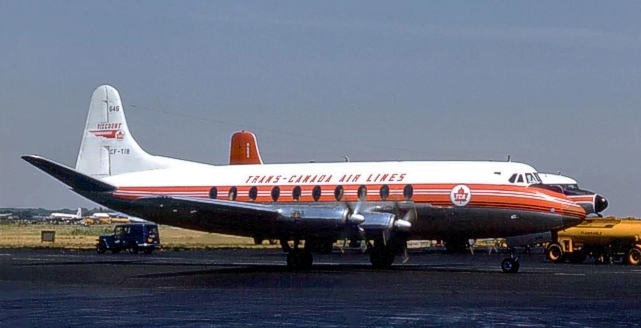
Viscount 757 c/n 310 CF-TIB of Trans-Canada Air Lines
Editor’s note: Most people will look on 11 September as the blackest day in aviation history with its 9/11 link. Not
everyone will have realised though that on the same day as the above Viscount hijacking, Air France Caravelle F-BOHB crashed
with the loss of all 95 on board while attempting an emergency landing at Côte D’Azur, near, Nice because of a fire on board.
Viscount C-FTID-X c/n 384 on the move
In the September 2011 newsletter we made reference to Viscount c/n 384 C-FTID-X being moved. Phil Belanger advised us
he had the contract to move the aircraft across Montreal to a firemen's school in Laval, Quebec.
Subsequently he has supplied photos of the move to share with us and comments, “The last move of this beautiful Viscount is
all over. The Viscount will be, I believe, very helpful to the aviation communities; training firemen properly will be saving
a lot of our aircraft and more of our aviation community. I, as a pilot and engineer, think it will be a very good use of the
aircraft. I will send you more details when they start to operate.”
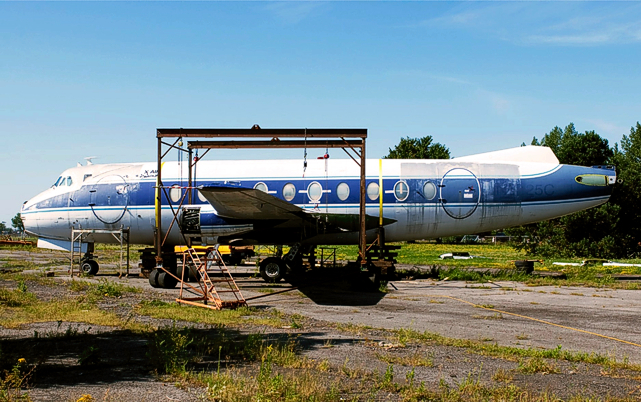
Viscount 757 c/n 384 C-FTID-X being dismantled for the move to Laval
We look forward to seeing the fire training in operation and hope that the Viscount will “stand the test” and be with us for
many years to come. Have a look at the history of this aircraft which includes a selection of photos of the move.
Terrorism Viscount
In a similar, but more extreme way, to help save lives we are told by Phil Turner of the blowing up of a derelict
Viscount. He takes up the story:-
"I am sure you probably have this information but thought I would pass it on. I have just watched Air crash confidential
on SKY, an episode titled ‘terrorism’. In this program they show the effect of a shoe bomb on a derelict fuselage, an ex BMA -
British Midlands Airways V.800 Viscount.
The registration is painted out but I could make out G-AZN but could not make out the last letter. The start of the letter was
vertical and close to the N so had to be either a B,D,E and so on. Going through the letters I got the feeling that it was
what was left of G-AZNB. Sad to see it getting blown up.
I used to work at Leeds/Bradford Airport and we had a BMA Viscount that had slid off the runway. I will try and scan the
photos we took at the time to send them to you."
Our historian Brian Burrage noted in appreciation;-
"Thanks for getting in touch with us about the documentary. I have watched the relevant section. A bit of a sad end but the
fuselage didn't look in good shape. The programme is dated 2010 which means it was probably shot in 2009. I have taken a few
stills to see what I can make of it for the website with due credit to the programme makers.
It has to be Viscount c/n 351 G-AZNB which I will now research to find out where it went to as this is one of the histories we
have yet to polish up. Do send us your photos from Leeds/Bradford Airport when convenient. Were you with Dan Air?"
Phil's contribution helps the Viscount team "complete the jig-saw", which is the underlying purpose of our Virtual Museum.
We are thin on the ground with photos of this aircraft’s career. Can readers have a look and see if they can find some
photos to fill the various gaps?
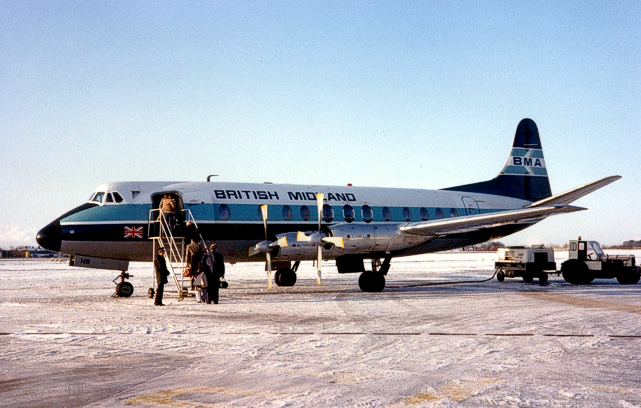
Photo of BMA - British Midland Airways Viscount G-AZNB
Jim Griffith and the 'talking overhead lockers'
In the last newsletter Jim told us about the 'Dog Whistles'. Here is a story he sent to our Canadian researcher Ron
Rhodes and wishes to also share with us.
"Hi Ron, I saw your photos in the Air Canada family 'netletter' of the TCA Viscount interior. Seeing the overhead racks
in the cabin in your photo reminded me of where we used to put the flight attendants. When I wrote the story my memory was
that those racks were much bigger than shown in your photo, nevertheless, that's where we put them.
One time, a flight attendant who was up in the rack was greeting passengers as they got on the aircraft and was taking their
boarding passes. The passengers must have been a little wide-eyed as a hand, from seemingly nowhere, reached out to take the
boarding pass!
I sent these Vickers Viscount stories to various magazines and so on including the ‘netletter’ and now the Vickers Viscount
Network is also going to print them. Current Canadian aviation magazines seem uninterested."
Strictly for the birds - another story from Jim Griffith
"7 September 1908, Orville Wright was on a sales promotion of his airplane, a Wright Flyer, demonstrating its turning
capabilities near Dayton Ohio.
Flying in circles might have dithered his thinking for he spotted a flock of birds and decided to chase them. Catching up
with the flock he whacked one on the head with his left wing and killed it a sort of . . . man bites dog, story.
Cal Rodgers, the first pilot to fly across the USA, was flying his Wright Flyer model B at Long Beach California in 1912,
when he hit a seagull in the front-mounted, pointy landing skid . . . birdie bits jammed the control cables . . . the plane
crashed and Cal became the first bird strike fatality in history . . . and he wouldn’t be the last.
To date there have been 288 bird strike fatalities. On 4 October 1960, Eastern Airlines, Lockheed Electra turbo-prop, N5533,
flew into a flock of starlings on take-off at Boston and crashed, killing 62 of the 72 on-board.
On 15 January 2009, US Airways Airbus A-320, N106US, would have more than doubled that death toll when it flew into a flock
of Canada Geese on take-off at La Guardia Airport and was ditched in the Hudson River. It was only thanks to the
experience-honed skills of the pilots and professionalism of the entire crew that everyone was safe."
The birds don't always lose . . .
The birds always seem to come off second best in the various bird strike stories we have reported however, according to a
New Zealand National Airways Corporation 'Skylines' magazine dated November 1966, a teleprinter message states;- "Due to a
sparrow doing circuits in cockpit shortly after take-off at Christchurch, flight 564 landed again at Christchurch to
off-load same. This added a further delay of 30 minutes."
From Weybridge to New Zealand via TCA - Part 4
Still on NZNAC and humour, Norm Hogwood continues his light-hearted recollections of his long association with
Viscounts in England, Canada and New Zealand. Norm tells us;-
"Some of the old pilots were real characters. One in particular was Jack Winefield who was renowned for pulling all
sorts of stunts. He was an NAC Viscount Captain when I first met him and I recall one day seeing him walking out to his
aircraft in Wellington, tapping a white stick on the ground and with his First Officer holding him by the arm. God knows what
the passengers thought.
Jack had a reputation of being a bit of a lady’s man but I believe it was more legend than fact. One day I was riding on the
flight deck of a Viscount with him flying between Wellington and Christchurch and I asked him about this reputation. He
explained that it was pure fantasy and gave me an example of how he failed miserably with the hostesses.
Before Auckland International Airport opened in 1965, at Mangere, the distant Air Force Base at Whenuapai served as Auckland
Airport. Consequently, when finishing late duties everyone had a fairly long journey home. Jack said that when his offer of
a lift home was accepted, the girls used to jump out the car, wish him good night, and slam the door.
While telling me this he exclaimed, 'and that makes me mad!', and stamped his foot heavily on the rudder bar! It was a
beautiful day with no turbulence whatsoever and the Viscount shuddered as his action commanded the rudder. The poor First
Officer, Jimmy Wood, who was also to become a good friend, wondered what on earth had happened and asked Jack what
he'd done. Jack just told him to keep looking ahead and fly the aircraft.
A few seconds later the flight deck door opened and in came the senior hostess who asked the same question saying that the
passengers were a bit concerned over how the aircraft had shaken. Jack just explained what he had been telling me about his
lack of success with her and her friends and repeated the rudder thumping!"
CF-TGI 'Tiggy' at the Pima Air & Space Museum, Tucson, Arizona - again
Jack Stephens has received more information from James Stemm at the museum who reports;-
"We still very much want to restore the Viscount into its TCA - Trans-Canada Air Lines markings and intend to do so. It had
actually been scheduled for this year, 2011, but a number of new regulations relating to workplace safety came into effect
this year and we have not been able to work on any of our larger aircraft due to new fall protection standards that we need
to upgrade our equipment to meet.
It is going to cost about ¾ of a million dollars to upgrade our restoration facility to meet these regulations. We are
working on raising the needed funds but it will probably be a couple of years at least until we are able to work on any of
the taller planes like the Viscount."
Recently the following was circulated around various aviation groups and there is the possibility that the Viscount will get
more attention in coming months;-
"Six retired military airplanes have been transformed into 'monumental works of art' for the Pima Air & Space Museum in
Tucson, Arizona, the museum announced. The 'Round Trip' exhibit that opened on 28 January, will feature former Air Force
aircraft that had been stored for years in desert 'Bone Yards'.
Aircraft used as canvases include four DC-3s, a Beechcraft C-45 (a military version of the Beech 18), and a Lockheed VC 140
Jetstar (a 1960s era twin jet used for military transport). The cockpit from a Boeing C-97 also was used as a canvas for the
show. More than 30 artists from around the world took part in the project.
The show is part of an on-going Boneyard Project, which launched last summer in New York with the 'Nose Job' show, which gave
the nose cones from about two dozen military aircraft to artists to use as 'canvases'. The Arizona exhibit will include some
selections from that show along with more than a dozen new projects that have not been previously exhibited.
The Pima Air & Space Museum maintains a collection of more than 300 aircraft and spacecraft from around the globe and houses
more than 125,000 artefacts. The "Round Trip" show is open to the public from 28 January through the end of May 2012.
Editor’s note: I received the above information through another group and realising that the Pima Air & Space Museum
has a Viscount I circulated the following;-
"The Pima Air & Space Museum is a focal point for Viscount enthusiasts as arguably their Viscount can lay claim to having
one of the most significant histories of all the Museum's exhibits. Their V.724 Viscount c/n 40 N22SN started life as CF-TGI
'Tiggy'.
The old girl is very much in need of some 'TLC' including a fresh coat of paint, TCA - Trans-Canada Air Lines colours would
be appropriate. In December 1954 she was the very first Viscount to migrate to North America and so became first of type in
the TCA - Trans-Canada Air Lines fleet.
Anyone visiting the Pima Air & Space Museum should make a point of standing beside "Tiggy" and breathing in her very
significant North American aviation history. If only aircraft could talk . . ."
STOP PRESS! Vickers Viscount Network Canadian researcher Ron Rhodes reports;-
Good news! I've just heard from James Stemm at the Pima Museum. I asked if I could get on board the Viscount to take
photographs when I visit the museum in a few weeks. I just got the reply:- YES! If anyone has any photograph
requests, please let me know what you would like . . . and possibly where I will find it/them on the aircraft.
Ron.Rhodes@VickersViscount.net
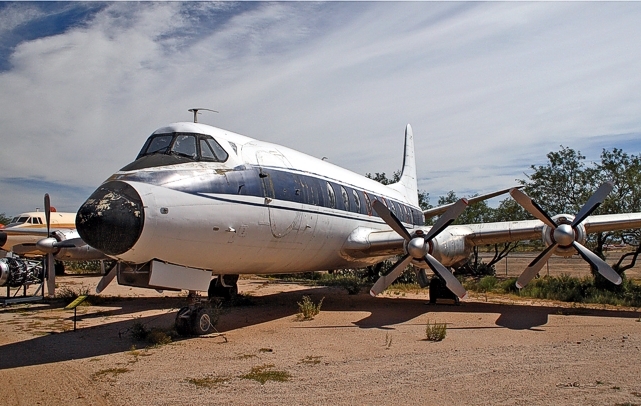
Viscount c/n 40 N22SN ex. CF-TGI at the Pima Air and Space Museum
The Vickers Viscount Network 2012 Get Together
Early plans have started for a possible Vickers Viscount Network 2012 Get Together at MAM - Midland Air Museum at Baginton,
Coventry, England to view the restoration progress of Viscount c/n 35 F-BGNR.
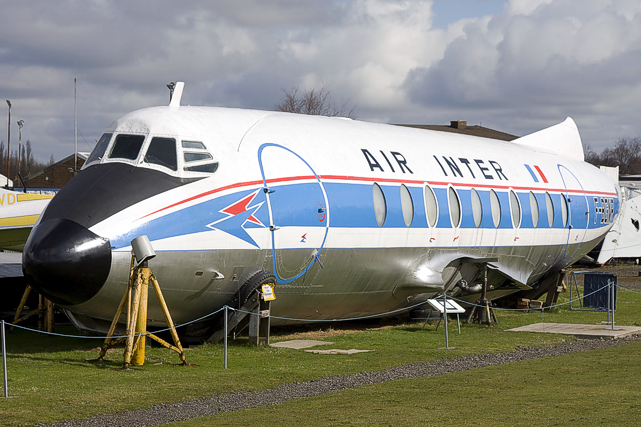
MAM - Midland Air Museum Viscount c/n 35 F-BGNR
Have a look at the photos we have in its history and you will get an idea of recent progress. The Vickers Viscount Network last
visited this Viscount in 2008 just after it had arrived at Coventry.
A date has not be finalised but it is suggested you keep both 22 and 29 September free. At this stage we are not collecting
names of those who wish to attend but as soon as possible we will let you know who to contact. Julian Bourn has once
again agreed to co-ordinate the get-together and intends to build on the standard set previously.
Those of us who have visited the museum, including New Zealand based editor Peter Layne who has been twice, can assure
you there is plenty to see, indoors and out. Have a sneak preview of the Midland Air Museum at their website.
www.midlandairmuseum.co.uk/news.php
How to send us information and photos
To provide information and photos for inclusion in the Virtual Museum or our Newsletters, please send them to;-
Membership@VickersViscount.net
Photos should be scanned as a JPEG (.jpg) ideally producing an image of at least 600 KB to give us something to work from.
Scanning prints at 600 DPI and slides and negatives at 1,200 DPI usually produces good results.
Don't worry about the condition of your photos as we can work wonders with most images that have strange colours or dust
marks, blemishes etc.
Newsletter Editorial and Production Team
Peter Layne - Chief Editor, Wellington, New Zealand.
Ed Jones - Editor, Manchester, England.
Simon Ellwood - Newsletter Production, Leeds, England.
Geoff Blampied - Website Production, Norwich, England
Although every endeavour is made to find an answer to questions, please appreciate that the team here at the Vickers Viscount
Network are all unpaid volunteers who fit this work in with their daytime jobs and chores around home. Any opinions expressed
in this publication are not necessarily those of the Vickers Viscount Network or the Newsletter Editors.